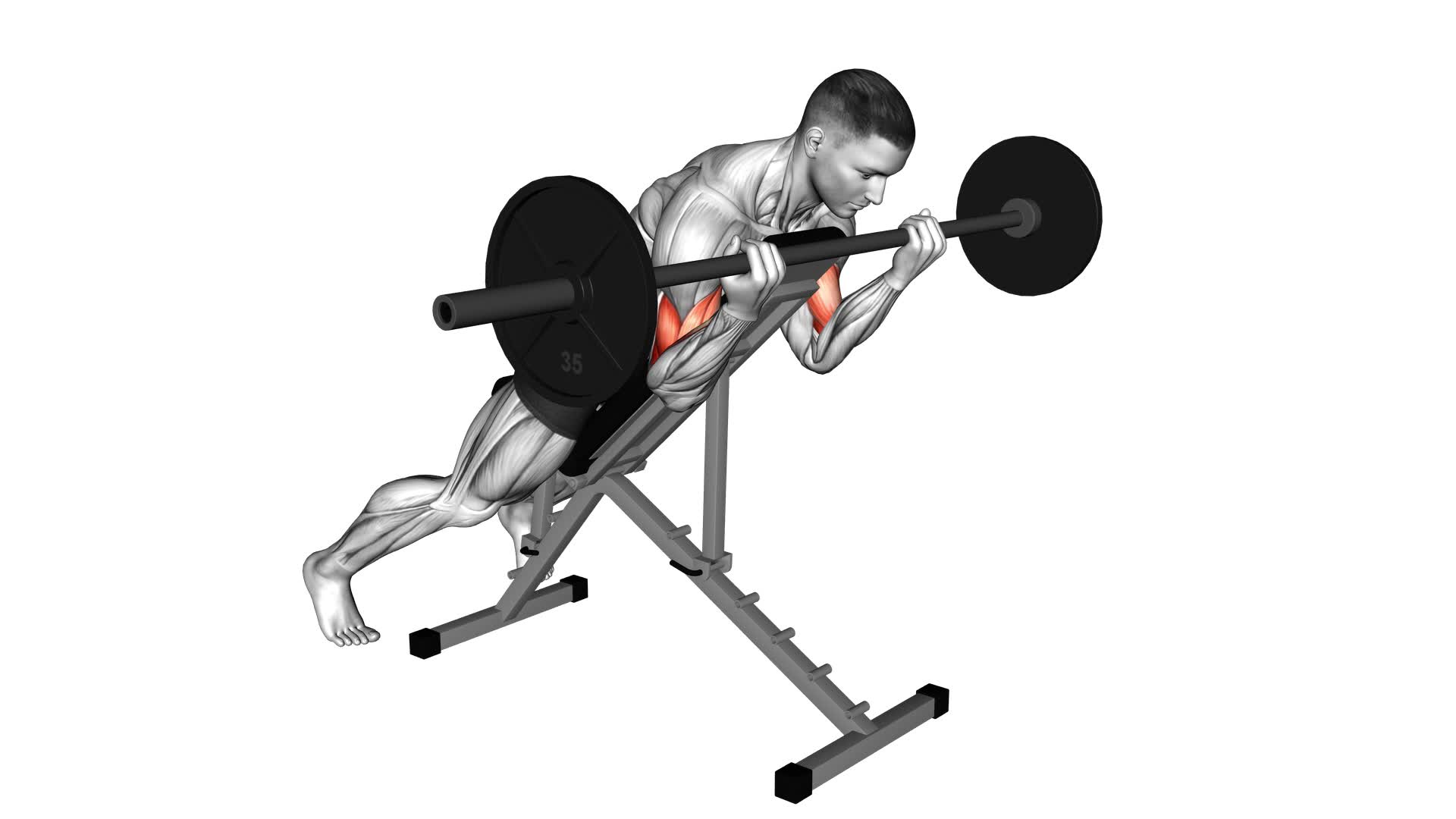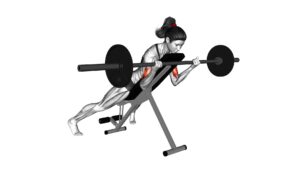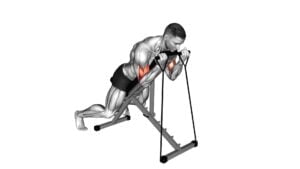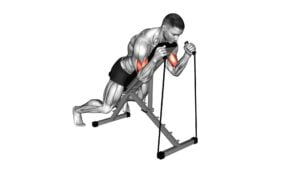Barbell Prone Incline Curl – Video Exercise Guide & Tips

Looking to build biceps strength and definition? The Barbell Prone Incline Curl is a powerful exercise that targets your upper arms.
Watch This Exercise Video
In this video guide, we'll show you the proper form and technique to ensure maximum results. You'll also learn about the equipment needed and common mistakes to avoid.
Ready to take your arm workout to the next level? Let's dive in and master the Barbell Prone Incline Curl for impressive gains.
Key Takeaways
- Barbell Prone Incline Curl targets biceps, brachialis, forearms, and shoulders.
- It helps in building strength and size in the upper arms.
- The exercise improves overall arm definition and enhances grip strength.
- It is important to maintain proper form and technique, avoiding common mistakes such as using momentum, arching the back, allowing elbows to flare outwards, and not fully extending the arms at the bottom of the movement.
Benefits of the Barbell Prone Incline Curl
Discover the numerous benefits you can gain from performing the Barbell Prone Incline Curl. This exercise primarily targets the biceps and the brachialis, leading to significant muscle activation in these areas. By incorporating the Barbell Prone Incline Curl into your workout routine, you can effectively build strength and size in your upper arms.
One of the advantages of this exercise is that it allows for variations and progressions. You can adjust the incline of the bench to target different parts of the biceps and increase the level of difficulty. Additionally, you can modify your grip to emphasize different muscles within the arm, such as the brachioradialis.
Another benefit of the Barbell Prone Incline Curl is that it promotes stability and balance. By lying prone on an incline bench, you engage your core muscles to maintain proper form and control throughout the movement. This not only strengthens your core but also enhances overall stability, which is essential for various daily activities and sports.
Proper Form and Technique
To perform the Barbell Prone Incline Curl with proper form and technique, follow these steps:
- Adjust the incline bench to a 45-degree angle.
- Lie face-down on the bench with your chest supported and your feet firmly on the ground.
- Grasp the barbell with an underhand grip, hands shoulder-width apart.
- Keep your elbows tucked in and your upper arms stationary throughout the exercise.
- Begin by slowly curling the barbell towards your shoulders, exhaling as you lift.
- Keep your wrists straight and avoid using momentum to lift the weight.
- Pause briefly at the top of the movement.
- Lower the barbell back down to the starting position, inhaling as you lower.
- Repeat for the desired number of repetitions.
When performing the Barbell Prone Incline Curl, there are a few common errors to watch out for. Avoid lifting your upper arms away from the bench or allowing your elbows to flare out. This can put unnecessary strain on your shoulders and diminish the effectiveness of the exercise. Additionally, be mindful of using too much weight, as this can compromise your form and lead to injury.
Variations and modifications of the Barbell Prone Incline Curl include using dumbbells instead of a barbell, alternating arms, or performing the exercise with a pronated grip. These variations can target different muscles and add variety to your workout routine. Remember to always start with lighter weights and gradually increase the resistance as your strength improves.
Incorporating proper form and technique into your Barbell Prone Incline Curl will help maximize the benefits of this exercise and reduce the risk of injury.
Equipment Needed for the Exercise
You will need some specific equipment to perform the Barbell Prone Incline Curl exercise. Here are the types of equipment you'll need:
- Barbell: This is the main equipment for the exercise. It's a long, straight bar with weights attached to both ends. Make sure to choose a barbell that's appropriate for your strength level.
- Bench: You'll need an incline bench to perform the exercise. The bench should be set at an angle of around 45 degrees. Make sure the bench is stable and secure before starting the exercise.
- Weight plates: These are the weights that you'll attach to the ends of the barbell. The weight plates come in different sizes, so choose the ones that challenge you but allow you to maintain proper form.
If you don't have access to a barbell or bench, there are alternative equipment options you can consider. Dumbbells can be used instead of a barbell, and an adjustable bench or even a stability ball can be used as a substitute for an incline bench.
Now that you know the equipment needed for the Barbell Prone Incline Curl exercise, let's move on to the next section about common mistakes to avoid.
Common Mistakes to Avoid
One common mistake to avoid when performing the barbell prone incline curl is improper form. Proper execution is crucial for maximizing the benefits of this exercise and preventing potential injuries. One common mistake is using too much weight, which can lead to compromised form and strain on the muscles and joints. It's important to start with a weight that's manageable and gradually increase as your strength improves.
Another common mistake to avoid is using momentum to lift the weight instead of relying on the targeted muscles. This can be easily corrected by maintaining a slow and controlled movement throughout the exercise. Focus on contracting the biceps and keeping the elbows stationary to ensure that the targeted muscles are being effectively engaged.
In addition, it's important to maintain proper posture during the exercise. Avoid arching the back or hunching the shoulders, as this can put unnecessary strain on the spine and reduce the effectiveness of the exercise. Keep the chest lifted, shoulders back, and maintain a neutral spine throughout the movement.
Lastly, make sure to use a proper grip on the barbell. Avoid using a grip that's too wide or too narrow, as this can place excessive stress on the wrists and forearms. Use a grip that's comfortable and allows for a full range of motion.
Tips for Maximizing Your Results
To maximize your results with the barbell prone incline curl, focus on proper form and execution while gradually increasing your weight and maintaining control throughout the exercise. By following these tips, you can enhance your muscle activation and prevent injury:
- Start with a light weight: Begin with a weight that allows you to maintain proper form and control throughout the movement. This will help you activate the target muscles effectively without compromising your technique.
- Engage your core: Keep your core muscles engaged throughout the exercise to stabilize your body and prevent excessive strain on your lower back. This won't only improve your form but also protect your spine from injury.
- Control the movement: Avoid using momentum or swinging your body to lift the weight. Instead, focus on a slow and controlled motion, both on the way up and on the way down. This will ensure that your muscles are fully engaged and working to their maximum potential.
Frequently Asked Questions
How Many Sets and Reps Should I Do for the Barbell Prone Incline Curl?
For the barbell prone incline curl, the optimal number of sets and reps depends on your fitness goals and current strength level. Generally, a good starting point is to perform 3-4 sets of 8-12 reps. This will help to build strength and muscle endurance.
However, it's important to listen to your body and adjust the weight and reps accordingly.
As for variations, you can try using dumbbells instead of a barbell or changing the incline angle to target different parts of the biceps.
Can I Substitute the Barbell With Dumbbells for This Exercise?
Yes, you can substitute the barbell with dumbbells for the barbell prone incline curl exercise. This exercise has variations that allow you to use either a barbell or dumbbells.
Using dumbbells for this exercise can provide additional benefits such as increased stability and a greater range of motion. Dumbbells also allow for unilateral training, which can help address muscle imbalances.
Is It Safe to Perform the Barbell Prone Incline Curl if I Have a Shoulder Injury?
If you have a shoulder injury, it may not be safe to perform the barbell prone incline curl. This exercise puts a lot of strain on the shoulder joint, so it's important to listen to your body and avoid any movements that cause pain or discomfort.
Instead, you can try modifying the exercise by using lighter weights or substituting the barbell with dumbbells.
Always consult with a healthcare professional or a certified trainer for personalized advice.
Should I Perform This Exercise at the Beginning or the End of My Workout?
At the beginning or the end of your workout, it's up to you. Both have their benefits and variations.
Starting with the barbell prone incline curl can activate your muscles and help you build strength.
On the other hand, ending your workout with this exercise can provide a good burnout and target your muscles when they're already fatigued.
Consider your goals and preferences to decide when to perform this exercise in your routine.
What Muscles Are Primarily Targeted During the Barbell Prone Incline Curl?
During the barbell prone incline curl, the primary muscles targeted are your biceps and brachialis.
This exercise is beneficial for increasing arm strength and size.
There are various variations of the incline curl, such as using dumbbells instead of a barbell or adjusting the incline angle.
Incorporating these variations can help target different areas of your biceps and provide a well-rounded arm workout.
Conclusion
In conclusion, the barbell prone incline curl is a highly effective exercise for targeting the biceps and building arm strength. By following proper form and technique, using the appropriate equipment, and avoiding common mistakes, you can maximize your results and achieve your fitness goals.
Incorporate this exercise into your routine for stronger and more defined biceps.

Author
Years ago, the spark of my life’s passion ignited in my mind the moment I stepped into the local gym for the first time. The inaugural bead of perspiration, the initial endeavor, the very first surge of endorphins, and a sense of pride that washed over me post-workout marked the beginning of my deep-seated interest in strength sports, fitness, and sports nutrition. This very curiosity blossomed rapidly into a profound fascination, propelling me to earn a Master’s degree in Physical Education from the Academy of Physical Education in Krakow, followed by a Sports Manager diploma from the Jagiellonian University. My journey of growth led me to gain more specialized qualifications, such as being a certified personal trainer with a focus on sports dietetics, a lifeguard, and an instructor for wellness and corrective gymnastics. Theoretical knowledge paired seamlessly with practical experience, reinforcing my belief that the transformation of individuals under my guidance was also a reflection of my personal growth. This belief holds true even today. Each day, I strive to push the boundaries and explore new realms. These realms gently elevate me to greater heights. The unique combination of passion for my field and the continuous quest for growth fuels my drive to break new ground.







